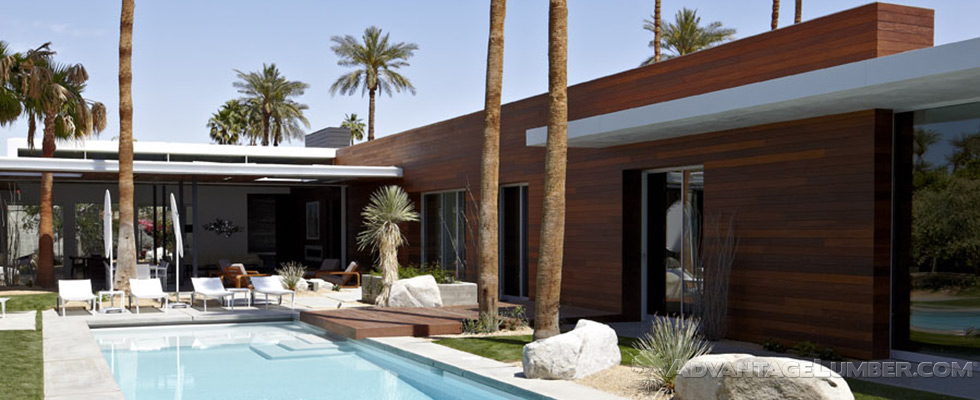Rainscreen Siding Installation
Easy to follow installation instructions for Advantage Rainscreen Siding.
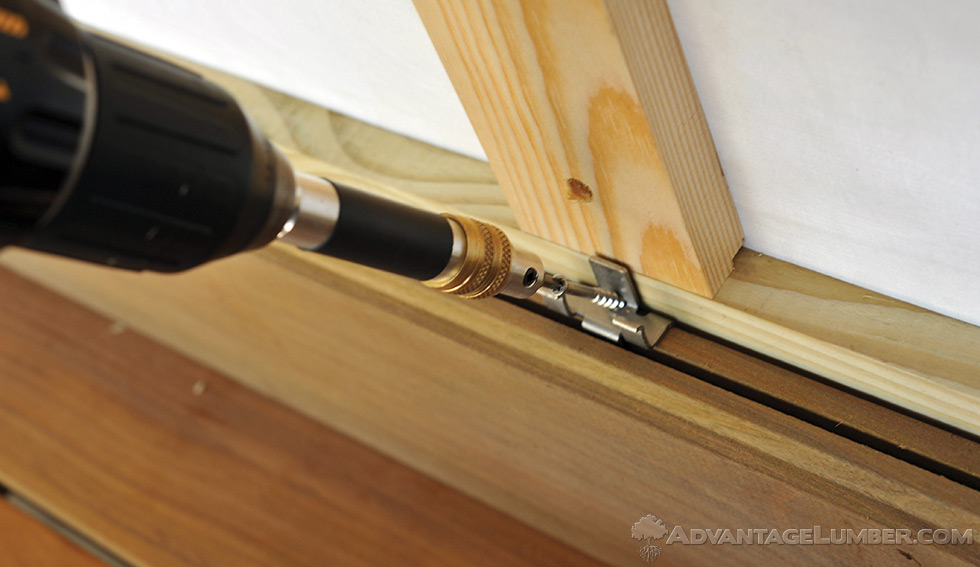
5/4 Rainscreen Siding Install
Prior to Installation
Always check with local building codes and an architect prior to constructing. Follow all building codes that apply in your area. Since there are many different variables one can encounter on an installation project, it is your responsibility to test the material for suitability for your project prior to constructing. Follow all manufacturers' installation instructions for the individual products used on the project. If any building codes or manufacturers installation instructions contradict or differ from information provided by AdvantageLumber.com, contact us for written clarification prior to starting your project.
Storage and Handling:

Hardwood siding should be allowed to sit where it will be installed for 7 days prior to installation in order to get acclimated to your local temperature and humidity levels. DO NOT store the siding directly on the ground, or directly on top of a concrete surface. DO NOT store the material for more than 30 days prior to use without first consulting with a sales rep at advantagelumber.com that your storage conditions are optimal. The siding should be elevated at least 12" off the ground during acclimation. To ensure the bottom boards are well ventilated, place the decking on top of blocks of wood. DO NOT cover siding material with plastic or a tarp during this acclimation period. Covering with a tarp/plastic will trap moisture in and cause stability issues. Covering the top of the pile with a sheet of plywood to shed the water is recommended. Keep material dry until installation. Also keep stickers (or wood shims) between layers of boards to allow proper air flow (see image below). DO NOT store the material in a garage or any other enclosed area.
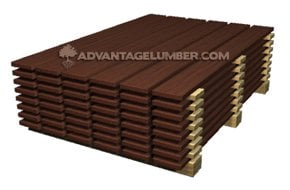
How To Install Advantage Rainscreen Siding
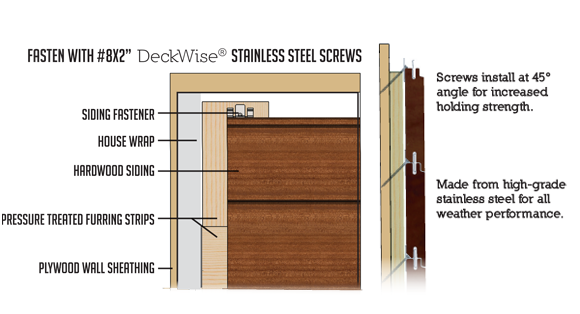


MATERIALS NEEDED:
- Advantage Rainscreen Siding
- DeckWise™ Hidden Siding Fasteners
- Stainless Steel Screws
- Cordless Drill
- End Seal
- Furring Strips (1x3 pine is typical)
- Base board (1x6 PT Pine is typical)
- Vapor Barrier
- Level
- Rubber mallet
- Chalk line
PRIOR TO INSTALLATION:
- Calculate how much siding you will need based on the "Net Finished Dimensions" only.
- Advantage Rainscreen Siding must acclimate to your local climate.
- Use Advantage End Seal to cover the ends of the grain of any freshly cut siding boards.
- Do you need a permit? Permission from your Homeowner's Association? Before starting any project, you must always check local building codes.
STEP-BY-STEP INSTALLATION GUIDE:
- Install house wrap to prevent moisture intrusion. (Always follow the vapor barrier manufacturer's instructions.)
- Install the baseboard (horizontal furring strip) with stainless screws. Ensure the baseboard is level.
- Align furring strips vertically on top of baseboard 16" on center. Attach furring strips.
- Install starter clips (included with the hidden siding fastener kit) on your baseboard. Align each starter clip with the furring strips installed in step 3. (TIP: use a chalk line reel to create a level line).
- Install the first Advantage Rainscreen Siding board on top of the starter clips. (TIP: Use a level to ensure this first board is aligned properly).
- Place hidden siding fasteners into the pre-molded groove
- Drive stainless steel screw through the siding fastener into the furring strip at a 45 degree angle.
- Set the proceeding siding boards on top of the installed siding fasteners. (TIP: Use a rubber mallet to align boards properly).
TIP: Where two pieces of siding abut against each other, use two fasteners. (Use two starter clips if there is more than one piece of siding installed on the baseboard).
This Advantage Rainscreen Siding is for use with DeckWise™ Siding Fasteners >
Allowable Shrinkage:
When installing Rainscreen Siding, install each board as tightly as possible to leave the smallest gaps between them in case shrinkage occurs. Average shrinkage is 1/8” on 4” wide boards and ¼” on 6” wide boards. Shrinkage varies depending on climate, installation site, and method of use.
Cutting & Drilling:
Due to the very hard nature of Rainscreen Siding, premium carbide tipped saw blades are recommended for cutting. Brad point drill bits or fostner bits provide cleaner holes than standard HSS twist bits.
End Sealing:
Our Rainscreen Siding is shipped with the end grain sealed with a clear wax to prevent any end checking and adverse movement. Fresh cuts should be sealed within 24hrs with end grain sealant. We sell end grain sealant by the quart, which is typically enough for 500 sq.ft. of siding. The end grain sealant is simply applied with a paintbrush and dries clear. DO NOT apply end seal to the surface of the siding. Any sealant that gets on the surface should be wiped off immediately.
Finishing:
Because of Exotic Hardwood's natural density and alkaline characteristics, many oil and water based finishes will not dry properly when applied. We recommend that you test any product on several sample boards to determine compatibility. The finish we sell and recommend is Ipe Oil™. We do not recommend the use of other finishes. Applying a finish approximately every two years (depending upon your local climate) can help keep the beautiful dark brown color. If you decide to let your deck weather, it will turn a silvery gray similar to teak. We recommend that you apply a coat of finish initially after deck installation, regardless of the final color desired. This can help ensure that the Ipe retains its oils and stability. For low ventilation applications, we recommend finishing deck boards on all four sides prior to installation but after acclimation.
***IMPORTANT DISCLAIMER***
You must contact your local building department before you begin designing your project. Your local building department (and/or Homeowner Association) will inform you of any zoning ordinances and buildings codes that specify where and how you can build. You are responsible for applying for and obtaining any and all required permits for your project.Advantage Lumber, LLC provides this information as possible suggestions only and will not be held liable for your project's suitability or should you choose not to obtain the required permits, or if you fail to comply with all zoning ordinances and building codes.
Conclusion:
If you have any questions, contact us for written clarification prior to starting your project.
By purchasing material from AdvantageLumber.com, you agree to comply with our Terms & Conditions.
Siding Installation Pro Tip: Vertical Siding Installation Done Right

So you’ve decided Advantage Rainscreen Siding™ is the right choice for your home renovation project. The only problem is that you want your home to stand out amongst the crowd of run-of-the-mill looks. For an eye-catching look not seen in many homes, vertical installation* of rainscreen siding is a definite possibility. When you combine the warm and inviting look of real, natural Advantage Hardwoods with an application such as vertical siding, you can get the dynamic look you are aiming for. Although, exotic hardwoods have a much better resistance to rot, mold, and decay, vertical installations of any type of siding will increase the potential for water intrusion.
Proper Installation of the Furring Strips is Key
What’s the best way to install vertical siding while decreasing the chances of water retention? Install furring strips diagonally.
The diagonal furring strips need to be nailed at 12” on center and at a 45° angle. Start installing on the right and work your way to the left. This will still allow the airspace to get the ventilation it needs. With this placement of the furring strips you can install the siding vertical, horizontal, or in a pattern.
Advantage Rainscreen Siding™ Fasteners
Use rainscreen siding fasteners for easy installation. To install start at the corner using the starter clip that comes with your fastener kit, and attach it to the side. Fasten the siding to the furring strips, make sure to drive the stainless steel screw at a 45°, and then place the next piece of siding in to the fastener with the pre-molded groove. Use a level to ensure the boards are aligned properly. When dealing with outside corners, you can use a vertical siding corner post.
Can You Install Furring Strips Horizontally?
Horizontal furring strips are not something that I recommend. While typical siding installation require furring strips to be installed vertically, this is not the case when it comes to vertical siding installation. If vertical siding was set onto horizontal furring strips, any water that intrudes would have no place to go. With that much water retention, problems like rot and decay will lead to even more problems like air leaks. Even if you take the time to cut enough slits in the strips for drainage, there is still no guarantee that it will be sufficient enough for the rainscreen siding to ventilate properly. Stick with vertical or diagonal furring strip placement for the best possible outcome.
Diagonal furring strips can open up doors when it comes to rainscreen siding patterns. Don’t you want to own a house that your neighbors will envy? It will look spectacular and will also help your siding last for years and years.
*PRIOR TO INSTALLATION: Although vertical installation is a creative choice for your siding project, you run the risk of increased water intrusion since water will run the length of the siding and possible enter through any open grooves.*
Rainscreen Siding Corner Trim Installation
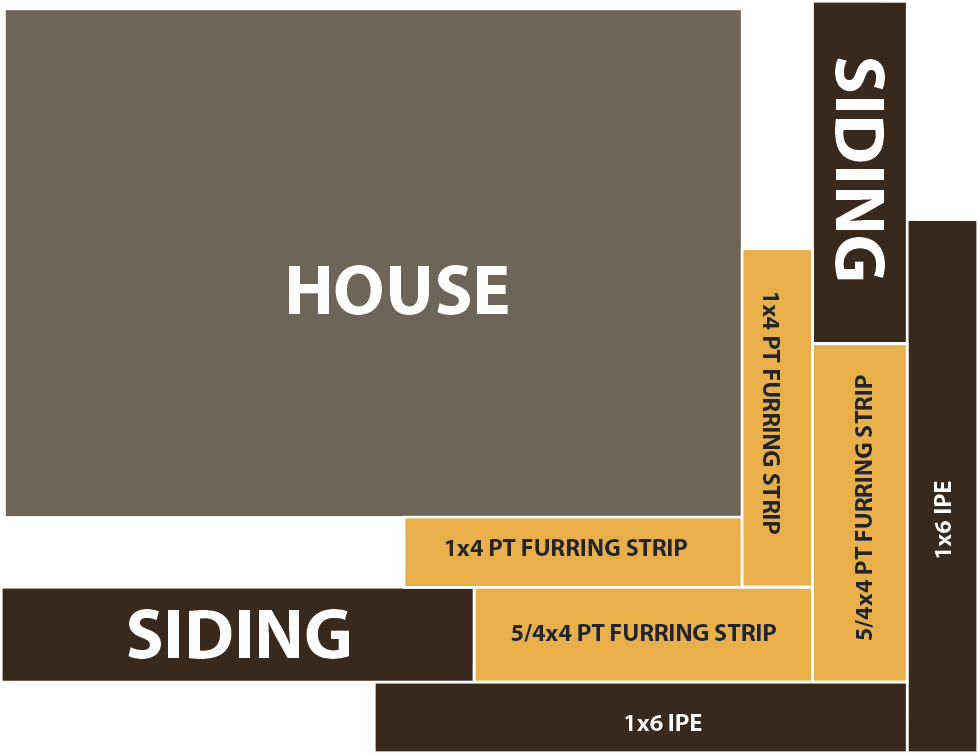



1x Rainscreen Siding Install
1x vs 5/4 Rainscreen Siding

1x Rainscreen Installation

What’s most notable about the DeckWise® 1x Hardwood Rainscreen Fastening System is that, we have omitted the need for cumbersome starter clips or starter rails. The design of our rainscreen fastener and easiness of installation fashions the fastener clip to act as a starter clip. This means no more fumbling for multiple clip shapes and sizes. It couldn’t be simpler to install hardwood rainscreen siding.
Hanging vertical hardwood rainscreen siding for new builds, remodeling, and re-siding projects will give you peace of mind and no worries of loose boards for years to come.
The DeckWise® extruded aluminum siding fastener comes with 3 predrilled holes for easy mounting and weep valleys for water drainage ensuring joints stay dry. The wide mounting flange also provides a sturdy base to ensure that hardwood siding/cladding is properly seated. Stainless-steel screws used for installation work together with the aluminum siding fastener to stave off any possible corrosion or galvanic action.
The unique design of the DeckWise® 1x rainscreen siding clip makes it a cost-effective system for installing Advantage hardwood rainscreen profiled siding such as Ipe, Cumaru, Garapa, and any of our other species of hardwood.1x Rainscreen Siding Fasteners

Install 1x Rainscreen Siding easily with DeckWise® 1x Hidden Siding Fasteners
